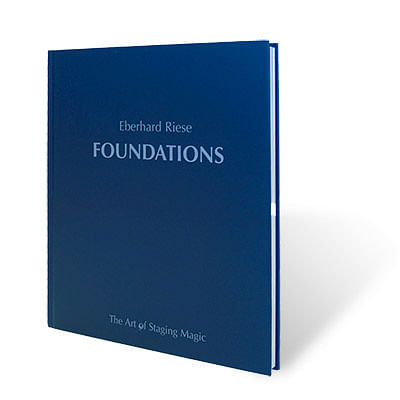Foundations: The Art of Staging Magic by Eberhard Riese
Reviewed by Jamy Ian Swiss (originally published in Genii November, 2006)

"Something strange has been happening in Stuttgart." So begins Jim Steinmeyer's foreword to Foundations: The Art of Staging Magic. Mr. Steinmeyer goes on to explain that Stuttgart has been "...turning out magicians great magicians, creative magicians, innovative magicians at a surprising rate."
The source of this mysterious phenomenon is apparently the book's author, one Eberhard Riese. Mr. Riese began as a magician, specializing in manipulation, but has, over the years, been drawn to a distinctive role as teacher, men-tor, and theatrical director of numerous stage acts on the German magic scene. The book in fact concludes with four pages listing magic acts that the author has "either co-developed or directed," naming almost 30 acts and their often multiple contest awards, at least a few of which will be known to Americans, including Junge, Junge! and Topas. (The latter, whose encouragement apparently led to the production of this book, also contributes a foreword.)
The book begins with a detailed discussion of the nature of ideas and how to generate them. Mr. Riese believes in assembling teams of collegial creators who brainstorm ideas together in an effort to produce fresh ideas. To bring magicians out of outmoded 18"' and 19'"-century imagery and effects, he wants to "clean the slate and start all over again." He presents guidelines for brainstorming, along with techniques like written charts of elements and ideas which can be connected in new ways in order to create new outcomes not unlike the brainstorming methods long used by comedy writers constructing jokes and monologues or, for that matter, in the business world.
The balance of the book is organized into three phases: theory and planning; practical application; and attainment and quality control. Early on we are presented with a diagram that demonstrates the building blocks of a magic act, that then leads into a discussion of character, offering not only examples of iconic characters from life and fiction, but also presenting an excellent set of questions designed to help build a "psychological orientation of a stage personality," including not only the obvious questions of "Who am I?" and "Where am I?" but also, "What do I want to get? How do I get it?" along with "Why do I want it?" and "What if I don't get it now?" And I would ask the reader this: How many silent magic acts in your experience have actually addressed and answered these provocative yet useful questions?
Mr. Riese is focused on modernity, and so in his section on costumes he offers many examples from contemporary men's fashion magazines, which contributes to the colorful and active design sensibility of this volume. Other subjects addressed in this theory and planning phase include objects, effects, methods, and plots; in discussing plots, the author offers an interesting chart of 20 plots drawn from narrative arts (and inspired by a book by Ronald B. Tobias). And this section also offers an excellent eight pages of advice and ideas for female magi.
The practical realization section includes notes on music, with solid, practical advice including a cogent argument against the use of fades. An extensive section on lighting will be invaluable to anyone creating a new stage act. The final, much shorter section of "Attainment Control" begins with a short consideration of stage fright, and goes on to explore how to construct full evening multi-act magic shows, as well as ideas for presenting magic on television.
I think that Mr. Rinse's approach and point of view, while ostensibly geared for "staging magic," will be of greatest use specifically to silent acts of general or manipulative magic, and especially as well to contest acts, where novelty invariably fairs well, often above all other considerations. (With regards to the former style, the author might wish to acquaint himself with the work of Teller and of Jeff Sheridan when discussing performers who have success-fully performed for decades in silence and without music.) The writer has very little to say about spoken word acts his two pages of advice on "patter" in the theory and planning section includes a list of "ten most important inspiration sources for patter" which contains several doubtful items that indeed may smack of the kind of "outmoded" performance elements that Mr. Riese otherwise derides with regard to other performance elements like apparatus, costume, stage dressing, and the like.
Mr. Riese declares himself, unsurprisingly, a fan of Darrel Fitzkee's famous theory textbook, The Trick Brain, and if you share my doubts about such a mechanistic approach to creativity, you may find similar limitations in Mr. Riese's work. Changing a prop may deliver a gloss of modernity, but it may not result in good art; to substitute the earth-bound specificity of an eyeball or a bottle opener two examples offered here as alternatives to balls may deliver results that are, in the often useful words of a colleague of mine, "more clever than good." If you're fanning and shuffling something, the audience probably recognizes that you've substituted some other notion for playing cards, and abandoning the universal aesthetic, emotional, and intellectual appeal of those objects in the name of modernity rarely produces an artistic victory.
However, in the case of magic contests, you can indeed should ignore the preceding paragraph, as con-test judges and amateur magicians will invariably value the clever over the good. If you're planning to enter FISM for general magic or manipulation, you need this book. And if you wish to do silent stage magic professionally, you will with an occasional garnish of caution unarguably benefit from this substantive, rigorous, useful volume.
